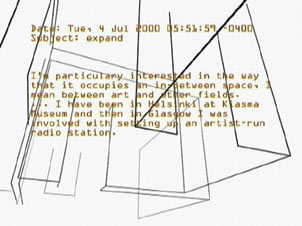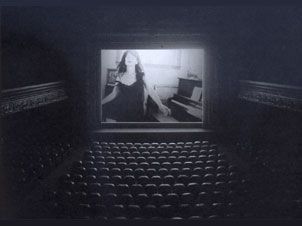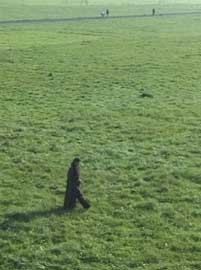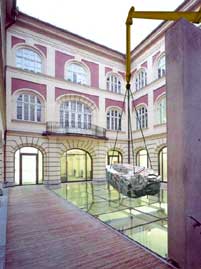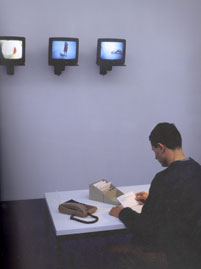| |
|||||||
| |
Performative Installation # 1 |
||||||
| |
|||||||
|
|
||||||
| |
|||||||
|
Artists Curators |
|||||||
| |
|||||||
| The exhibition "Given...
Construction and Situation" kicks off a five-part series of exhibitions
entitled Performative Installation, an initiative of the Siemens
Arts Program in cooperation with Galerie im Taxispalais in Innsbruck,
Museum Ludwig in Cologne, Museum of Contemporary Art Siegen, Vienna
Secession, and Gallery for Contemporary Art Leipzig. Each of the venues
deals with the same joint theme but from different perspectives: Construction
& Situation, Narration, Communication, Body & Economy and
Architecture.
Forming the focus of the exhibition "Given... Construction and Situation" are constructed situations in which reality is "staged". Even the titles of the works are directly or indirectly suggestive of the given structures involved in their conception: the relationship to a space – a location – which functions within the exhibition as a real scenario and, at the same time, as a symbolic construct so as to locate the audience in a constant crossover between the real and the fictitious. Within these "constructed situations" beholders are purposely shifted onto a both interactive and reflective plane in order to see themselves reflected in the filmic, emotional, narrative, virtual and other scenarios whose valuation parameters are subject to constant shifting. The staged spaces have a concrete relationship to a specified social context and to both private and public everyday experiences with different political and cultural contexts. In Emmanuelle Antille's "Training Lounge" (1997) we see an office whose "normality" penetrates another reality like in a daydream where we see video sequences from the living space of a disturbed young woman. The protagonist of Antille's Training Lounge looks so irritating here because her film space – in which she seems so self-absorbed, as if in unobserved privacy – is extended into the real space. The telephone ringing on the desk is not addressed to anyone; the call cannot reach the woman in the film and clearly indicates to the individuals in the audience that they, too, are excluded and isolated – a paraphrase for the experimental set-up of a media-controlled society. For "The Muriel Lake Incident"(1999)
Janet Cardiff & George Bures Miller built a small version
of a movie theatre where the audience (a maximum of three people
at a time) can view the show. The image and sound illusionism of
this cinema is so perfect that the viewers equipped with headphones
start to doubt their own perception. In her installation "Stoned" (2003) Ayşe Erkmen relates to the architecture of the exhibition space honing in on its most fragile part – namely the transparent glass roof of the hall on the ground floor – to stage here something unexpected, something threatening: a rock which Erkmen has suspended like a sword of Damocles above the glass roof in a constructive and poetic show of strength transforming the exhibition space into an apparently dangerous place. By doing this she manages to "short-circuit" the architectural and cultural history of Innsbruck with its Tyrolean mountain landscape whose topography, whose mineral resources like silver and salt and whose subsequent tourist exploitation contributed to the Tyrol's economic and cultural wealth. While in these three works the narrative is linked to the fictitious Maja Bajević and Emanuel Licha tell a real story. In the video installation "Green, Green Grass of Home" (2002) they involve the audience in their emotional reminiscing which begins to implant itself in their heads like an "after-image" of the war and fighting in Sarajevo: Bajević stands alone in the middle of a green meadow and tells a story. She reconstructs her flat lost in the war in Sarajevo which she could never enter again. Licha then draws ground plans following her description and builds a model which both can just about stand up in. The "Studio" (2000) by Karl-Heinz Klopf/Sigrid Kurz and Andreas Fogarasi's project bearing the working title "Innsbruck, Tyrol, Austria" (2003) refer to institutional spheres. The "Studio" is a white box into which a wall-sized, animated film reconstruction of Klopf/Kurz's Vienna studio space is projected via computer. The loose coordinates of this studio are subject to constant change like in a video game, while at the same time the outside world submits anonymous messages dealing with urban issues via the Internet – an allegory for unstable location within a globalised, electronically wired world. Andreas Fogarasi deals with the institutional specifications of a geographic location in both the content-based and in the material, object-related sense. Expression is given to his reflections on cultural policy and aesthetic specifications in the exhibition world or in tourist advertising within the setting of the exhibition space itself which reflects these specifications and transforms them at the same time. By adopting forms of display from the world of commerce he alludes to how the exhibition world is also part of the culture industry. Fogarasi's criticism is directed not least at "ambient art" which is desired by politics and aimed at entertaining the audience attempting to transfer tourist categories into the exhibition space. |
|||||||
| |
|||||||
|
|||||||
| |
|||||||
| Catalogue Performative Installation Ed. Angelika Nollert Contributions by Silvia Eiblmayr, Barbara Engelbach, Kasper König, Christine Litz, Angelika Nollert, Michael Roßnagl, Eva Maria Stadler, Barbara Steiner (German/English) Snoeck Verlagsgesellschaft mbH, Köln 2003 256 pp., 184 ill. € 19,80 ISBN 3-936859-05-1 |
|||||||
| |
|||||||
|
